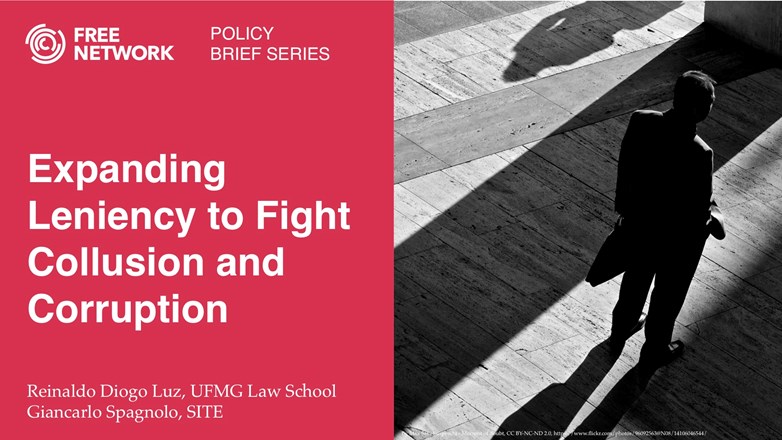Expanding leniency to fight collusion and corruption
Leniency policies offering immunity to the first cartel member that blows the whistle and self-reports to the antitrust authority have become the main instrument in the fight against cartels around the world. In public procurement markets, however, bid-rigging schemes are often accompanied by corruption of public officials. In the absence of coordinated forms of leniency for unveiling corruption, a policy offering immunity from antitrust sanctions may not be sufficient to encourage wrongdoers to blow the whistle, as the leniency recipient will then be exposed to the risk of conviction for corruption. Explicitly introducing leniency policies for corruption, as has been recently done in Brazil and Mexico, is only a first step. To increase the effectiveness of leniency in multiple offense cases, we suggest, besides extending automatic leniency to individual criminal sanctions, the creation of a ‘one-stop-point’ enabling firms and individuals to report different crimes simultaneously and receive leniency for all of them at once if they are entitled to it.
Leniency provisions to fight corruption
It has been noted that leniency policies and other schemes that encourage whistleblowing — such as reward and protection policies — should work in the fight against corruption as it does in the fight against collusion (Spagnolo, 2004; Spagnolo 2008; Buccirossi and Spagnolo, 2006). Cartels, corruption, and many other types of multi-agent offenses depend on a certain level of trust among wrongdoers, which is precisely what leniency programs aim to undermine by offering incentives for criminals to betray their partners and cooperate with the authorities (Bigoni et al., 2015; Leslie, 2004).
Of course, for offenses not covered by antitrust law, such as corruption, relevant authorities may have their own ways of granting leniency and encourage reporting, such as plea bargaining, whistleblower reward programs, deferred prosecution agreements (DPAs) and non-prosecution agreements (NPAs). On the other hand, some countries have recently introduced explicit leniency programs for corruption (for example, Brazil and Mexico). Yet, we observed that those instruments do not always cover all types of sanctions, are seldom integrated with antitrust leniency, and are often under the responsibility of multiple law enforcement agencies. Hence, improvements in the legal frameworks seem to still be necessary.
Leniency in a multi-offense scenario: the case of corruption cartels
Cartel offenses may be connected to other infringements. A particularly frequent and deleterious example of a multiple offense situation is the simultaneous occurrence of collusion (bid rigging) and corruption in public procurement (OECD, 2010). While cartels are estimated to raise prices by 20% or more above competitive levels (Connor, 2015; Froeb et al., 1993), corruption may add 5–25% to total contract values (EU, 2014; OECD, 2014b). Since public procurement is a market amounting to 13–20% of GDP in developed countries (OECD, 2011), it is clear that collusion and corruption represent a serious waste of public funds, negatively impacting the quality of public infrastructure and services provided by a state to its citizens.
Authorities face then two distinct, yet inter-related, challenges to guarantee the effectiveness of public procurement: ensuring integrity in the procurement process and promoting effective competition among suppliers (Anderson, 2010). Considering that success in deterring cartels and corruption depends largely on the incentives provided to infringers to self-report, the interaction between leniency provisions for cartels and the legal treatment of corruption adds a powerful new channel to the above-noted interdependence and thus should be — and already is — a concern to antitrust and anti-corruption authorities (OECD, 2014a).
A member of a corrupting cartel that blows the whistle on the cartel and applies for leniency to the antitrust authority will likely have to disclose information on the other infringement. Such information may then be used by the relevant law enforcement authority to prosecute and punish the applicant. Thus, the risk of prosecution for other cartel-connected offenses (corruption in this case) may reduce the attractiveness of reporting the cartel (Leslie, 2006). This kind of uncertainty works against the leniency policy’s deterrence goals and may even stabilize the cartel by providing its members with a credible threat to be used to prevent betrayal among them.
Existing leniency provisions for corrupting cartels
Antitrust leniency provisions are very similar worldwide, differing mainly in terms of whether cartels are only considered administrative infringements or are also criminally liable offenses. Where there is individual criminal liability, leniency programs should cover it. Surprisingly, Austria, France, German and Italy, where cartel, or at least bid rigging, is a criminal offense, do not follow this guideline. In these jurisdictions the co-operation of an individual with the antitrust authority during the administrative proceedings may be considered a mitigating circumstance, reducing imposed penalties or even allowing a discharge, but at the discretion of the court or the prosecution, which is likely to greatly reduce the propensity of wrongdoers to blow the whistle.
On the other hand, countries do not usually have specific leniency programs for corruption. Nonetheless, self-reporting and cooperation in bribery cases are usually given great importance by authorities and may lead to leniency and even immunity, through other mechanisms such as plea agreements, no-action letters, NPAs or DPAs, but those instruments rely on prosecutorial or judicial discretion. Brazil and Mexico do have formal leniency programs for corruption, providing more certainty and thus being more attractive to an applicant, although restricted to administrative liability. Individual corruption-related criminal provisions are laid down in each country’s criminal code and follow the recommendations made by the United Nations, in the 2003 Convention against Corruption, and by the Organization for Economic Co-operation and Development, under its 1997 Convention against Corruption of Foreign Public Officials in International Business Transactions.
Since enforcement authorities for collusion and corruption differ in most cases, such an arrangement demands that the infringer seek non-prosecution through at least two separate agreements, one with the antitrust authority and the other with the anti-corruption agency. The difficulty in coordinating such agreements is an obvious issue and will vary according to the number of authorities involved and to the proximity among them, that range from divisions of the same agency, in the case of the United States (Antitrust and Criminal Divisions of the Justice Department), to organizations from different government branches (Executive and Judiciary) in most jurisdictions.
In Brazil and the United States, antitrust leniency programs can provide protection for non-antitrust violations, committed in connection with an antitrust violation. While in Brazil, this provision does not currently include corruption infringements, in the United States it does, but only binds the Antitrust Division and not any other federal or state prosecuting agencies, i.e. leniency agreements may not prevent other authority from prosecuting the applicant for the non-antitrust violation.
How to improve the current legal framework
Countries should follow Brazil and Mexico’s example and create ex ante, non-relying on prosecutorial or judiciary discretion leniency programs for corruption infringements. Unlike these programs, leniency should also cover individuals, especially in terms of criminal liability for bid rigging and corruption. The protection from lawsuits for managers and directors could then become a primary incentive for them to blow the whistle on their and their companies’ illegal acts.
Additionally, it is advisable not to depend on collaboration between law enforcement groups, but to establish clear legal provisions to allow wrongdoers to report all illegal acts simultaneously and to be confident that they will escape sanctions upon co-operation with the authorities and presentation of evidence, i.e. the creation of a ‘one-stop point’.
This ‘one-stop point’ should be available for applicants at every law enforcement agency and must prevent other agencies from prosecuting the leniency applicant. In other words, when someone approaches—as an individual or as a representative of a legal person—any authority to report crimes he is involved in, it is important to allow him to report any other crimes that he knows about in exchange for lenient treatment. In order to prevent conflicts among agencies, the authority first contacted by the wrongdoer must be obliged to immediately involve any other one who may be competent over other possible reported infringements. The self-reporting wrongdoer must be reasonably certain that he will be granted leniency for all reported wrongdoings, provided that he fulfills the legal requirements for each infringement, obviously. Failing to report all known involvement in infringements may be a reason to reduce or even revoke leniency altogether, creating a penalty plus-like provision over different areas of law and a more powerful incentive to a thorough self-report.
Information about the possibility of reporting several illegal acts at the same time, and of obtaining leniency for each one, must be consistently disseminated to minimize detection and prosecution costs, as well as to contribute to the deterrence of future criminal behavior.
Finally, we note that companies and individuals from jurisdictions where leniency provisions for corruption are highly discretionary or non-existent would be less inclined to report cartel behavior abroad when bribing foreign public officials. Despite existing confidentiality rules on leniency programs, they might not want to risk being prosecuted for corruption at home. This would possibly block antitrust leniency agreements by removing the incentives to self-report, undermining the ability to catch international corrupting cartels. To prevent that, laws should be amended to allow leniency for a company or someone that self-reports abroad, and further coordination and collaboration between agencies from different countries would be necessary to avoid stabilizing criminal collusion and undermining the effectiveness of leniency programs.
Conclusion
The fight against cartels and bribery requires efforts on a national level as well as multilateral co-operation.
Creating leniency policies to fight corruption, including foreign, and coordinating them with antitrust leniency policies, emerges as an important priority. The absence of formal leniency programs for corruption, besides hindering anti-corruption enforcement, reduces wrongdoers’ incentives to blow the whistle and collaborate in corrupting cartel cases through the risk of criminal prosecution for the corruption offense. These programs must be carefully designed, however, to avoid opportunistic behavior and thus to achieve their goal of deterrence.
In order to increase the effectiveness of leniency programs in multiple offenses cases, we suggest the creation of a ‘one-stop point’, enabling firms and individuals to report different crimes simultaneously and obtain leniency, provided that they offer sufficient information and evidence for their partners in crime to be prosecuted.
References
- Anderson, R. D.; Kovacic, W. E.; Müller, A. C., 2010. Ensuring integrity and competition in public procurement markets: a dual challenge for good governance, in The WTO Regime on Government Procurement: Challenge ond Reform (Sue Arrowsmith & Robert D. Anderson eds.).
- Bigoni, M., Fridolfsson, S.O., Le Coq, C., Spagnolo, G., 2015. Trust, Leniency and Deterrence, 31 J. LAW ECON. ORGAN., 663.
- Buccirossi P.; Spagnolo, G., 2006. Leniency policies and illegal transactions, 90 J. PUBLIC ECON., 1281.
- Connor, J. M., 2014. Cartel overcharges, in The Law And Economics Of Class Actions (James Langenfeld ed.).
- European Commission, 2014. Report from the Commission to the Council and the European Parliament—EU Anti-Corruption Report 2014.
- Froeb, L. M.; Koyak, R. A.; Werden, G. J., 1993. What is the effect of bid rigging on prices?, 42 ECON. LETT., 419.
- Leslie, C. R., 2004. Trust, Distrust, and Antitrust, 82 TEX. L. REV. 515.
- Leslie, C. R., 2006. Antitrust Amnesty, Game Theory, and Cartel Stability, 31 J. CORP. L. 453.
- OECD, 2010. Global Forum on Competition Roundtable on Collusion and Corruption in Public Procurement.
- OECD, 2011. Public Procurement for Sustainable and Inclusive Growth – Enabling reform through evidence and peer reviews.
- OECD, 2012. Improving International Co-Operation in Cartel Investigations.
- OECD, 2014a. 13th Global Forum on Competition Discusses the Fight Against Corruption, Executive Summary.
- OECD, 2014b. OECD Foreign Bribery Report: An Analysis of the Crime of Bribery of Foreign Public Officials.
- Spagnolo, G. 2004. Divide et Impera: Optimal Leniency Programs, CEPR Discussion Paper nr 4840, available at: http://papers.ssrn.com/sol3/papers.cfm?abstract_id=716143
- Spagnolo, G., 2008. Leniency and Whistleblowers in Antitrust, in Handbook of Antitrust Economics (Paolo Buccirossi ed.), Cambridge MA: MIT Press.
- Stephan, P. B., 2012. Regulatory Competition and Anticorruption Law, 53 VA. J. INT. LAW 53.
- Waller, S. W., 1997. The Internationalization of Antitrust Enforcement. 77 BOSTON U. LAW REV. 343.




